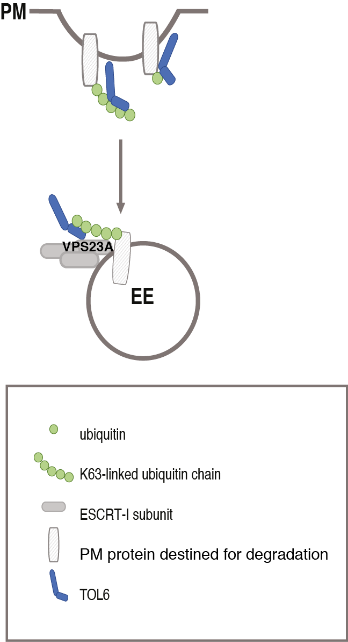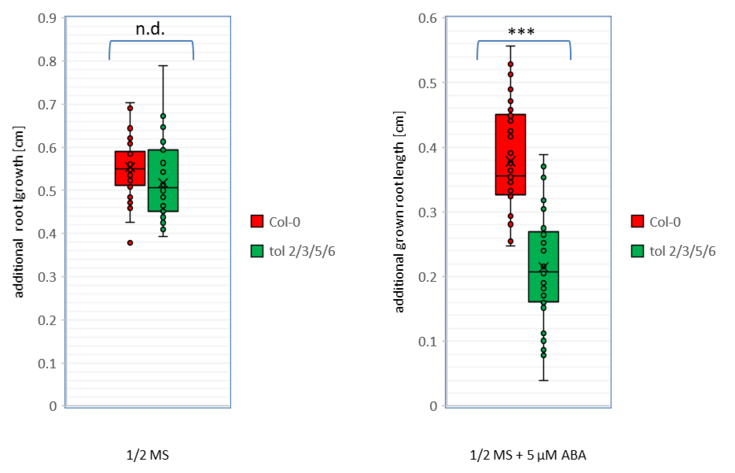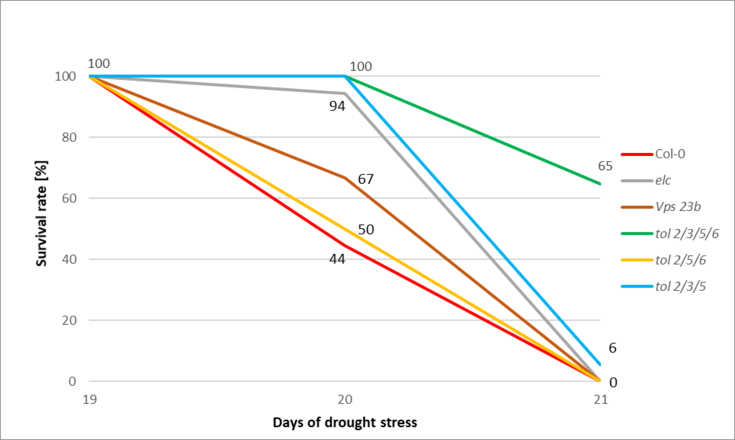TOL proteins, modulators of the endosomal degradation pathway during abiotic stress responses
SUPERVISORS: Barbara KORBEI
PROJECT ASSIGNED TO: Maximilian SCHWIHLA

Within the next years, my PhD project strives to unravel essential mechanisms in the intracellular trafficking of higher plants by investigating a protein family, which functions at the initial steps of ESCRT (Endosomal Sorting Complex Required for Transport)-dependent protein degradation and thus contributes to adaption mechanisms of plants. The TOL (TOM1-like) proteins are thought to be responsible for initiating a pathway of guiding ubiquitinated plasma membrane (PM) proteins to the vacuole for their degradation (see figure 1).
Figure 1 from: (Moulinier-Anzola et al., under review) Model for the potential function of TOL6 in the early degradation pathway of PM proteins.
A higher order (quadruple mutant) tol mutant, with no apparent phenotype when grown under standard conditions, is hypersensitive to the plant hormone abscisic acid (ABA) regarding germination and root development and shows enhanced drought tolerance (see figure 2). Thus, specific TOL proteins may play an important role in the ABA pathway, potentially in the degradation of membrane associated transporters and receptors. This further indicates that the TOLs could not only play a general role in the endosomal degradation pathway but also a more differentiated role in different signaling pathways, allowing them to fine tune responses of plants to their ever-changing environment.
The aim of my thesis will be to elucidate activities of individual TOLs and to assess the role of the TOLs in specific aspects of the ABA pathway, as TOLs function in the early steps of degradation of PM proteins via the ESCRT machinery, which also targets key components of the ABA signaling pathway. This increases the knowledge on the molecular framework underlying the regulation of ESCRT-dependent degradation of ubiquitinated proteins, which will be of decisive importance to fully understand the adaptation of plants to their changing environment.


Figure 2: Sensitivity of tol mutant plant lines to ABA and drought stress
A) Root length differences between Col-0 and tol2/3/5/6. Additional root growth was measured and depicted as box blot and analyzed by one-way ANOVA with post-hoc Tukey HSD test; p-values: ***p ≤ 0.001). While there is no difference between the additional root growth for untreated samples (blue box plots), a clear difference can be seen for treated samples (grey box plots) B) Drought Assay: Percentage of the plants that survive the indicated days of drought stress after three days of re-watering. VPS23A and VPS23B are ESCRT-I subunits.
